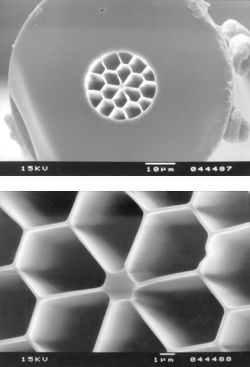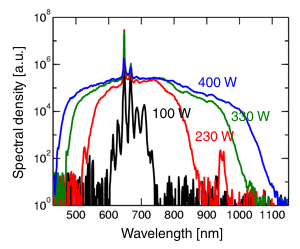
Optoelectronics group, Department of Physics
University of Bath
Bath, BA2 7AY, United Kingdom

 The development of photonic crystal fibers (PCF) has recently led to the
demonstration of white-light SC generation directly from unamplified
femtosecond Ti:Sapphire oscillators [5]. PCF are made up of a pure silica
core surrounded by an array of microscopic air holes running along their
entire length (see the scanning-electron micrographs to the right).
The large refractive-index step between silica and air allows light to be
concentrated into a very small area, resulting in enhanced nonlinear
effects.
Moreover, because of the large waveguide contribution to their
group-velocity-dispersion, PCF can exhibit very unusual chromatic
dispersion characteristics. These two properties are the key for
efficient supercontinuum generation.
The development of photonic crystal fibers (PCF) has recently led to the
demonstration of white-light SC generation directly from unamplified
femtosecond Ti:Sapphire oscillators [5]. PCF are made up of a pure silica
core surrounded by an array of microscopic air holes running along their
entire length (see the scanning-electron micrographs to the right).
The large refractive-index step between silica and air allows light to be
concentrated into a very small area, resulting in enhanced nonlinear
effects.
Moreover, because of the large waveguide contribution to their
group-velocity-dispersion, PCF can exhibit very unusual chromatic
dispersion characteristics. These two properties are the key for
efficient supercontinuum generation.
In contrast to most previous experiments that were relying on femtosecond pump pulses [4,5], we have studied SC generation in PCF with much longer picosecond pump pulses (~ 60 ps). The figure at the top of this page, that shows the spectrum of the light leaving a 10m-long PCF excited with 700 W peak power pulses, demonstrates that SC generation is also possible in those pumping conditions, therefore revealing that ultra-broadband white-light SC generation does not require a complex ultrafast laser.
In our experiments, the spectral broadening has been identified has being due to stimulated Raman scattering and parametric four-wave mixing generation, with a negligible contribution of the self-phase-modulation of the pump pulses [6]. The observation of a strong anti-Stokes Raman component has also revealed the importance of the coupling between stimulated Raman scattering and parametric four-wave-mixing in highly nonlinear photonic crystal fibers, and has also indicated that non-phase-matched processes contribute to the continuum. Additionally, the pump input polarization affects the generated continuum through the influence of polarization modulational instability. To complement our experimental study, a detailed numerical model of SC generation in PCF has also been developed. The numerical results are in good agreement with the experiments. These findings demonstrate the importance of index-guiding photonic crystal fibers for the design of picosecond or nanosecond supercontinuum light sources.
In our talk, we will give a review of past and present supercontinuum experiments and we will describe the different mechanisms and techniques that can be used to generate a supercontinuum spectrum. We will then present our most recent experimental and numerical results.
* Permanent address: Service d'Optique et d'Acoustique, Université Libre de Bruxelles, Av. F.D. Roosevelt 50, CP 194/5, B-1050 Brussels, Belgium
|
The figure to the right illustrates the broadening of
the spectrum and the formation of the supercontinuum for increasing peak
input powers. The PCF used here was 3 m long.
|
 |